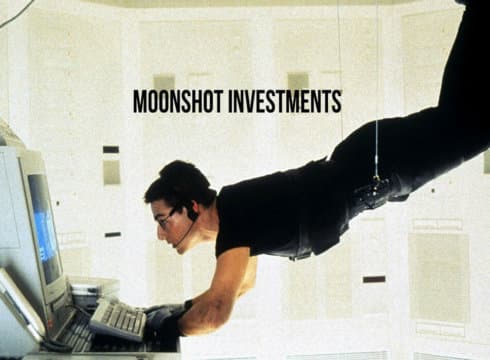Moonshot Investing Is A Function Of Your Reasoning And Your Imagination
Inc42 Daily Brief
Stay Ahead With Daily News & Analysis on India’s Tech & Startup Economy
Idea’s which can have a major impact on our lives. How far is too far when it gets into investing in crazy ideas with crazy potential to generate returns for investors.
Let me share some of my moonshot investments on no name basis. I just love being able to brag about these portfolio companies grand ideas.
Moonshot investing is a function of your reasoning and your imagination
There is unlimited potential for the creation of human environments in space around Earth, the Moon and Mars. If we are going to have the technology and capabilities needed for tomorrow, we have to invest in them today so I ended up investing in world’s first commercial space station.
The company intends to build multiple space stations for commercial operations. The ISS (International Space Station) is scheduled to lose U.S. funding in 2025 and even if its life is extended to 2028 NASA and other governments are seeking a commercial replacement. Current spend on the human flight to ISS is $2 Bn per year and is expected to be $6 Bn per year by 2030.
The company offers at 50X lower cost than ISS. The company is set to generate revenue of more than $ 100 Mn this year. It’s said that outlier hits is all about making money, moonshots don’t just make money, they also impact the world in a significant way.
I invest in founders that have experience behind them, subject matter experts and can effectively execute.
All electronic devices need power. Power transmission through the air in unlimited amounts with no loss is called wireless power. The company makes charging of devices as seamless as WiFi, removing one of the final barriers impeding electronics today and enabling new technologies.
Wireless power is a whole new paradigm, and it’s time to begin the new revolution. It requires no plugs, wires, or charging pads. With a cable, you have one socket charging one device.
Wireless power works like Wi-Fi in that you have one source feeding dozens or even hundreds of devices—phones, your kids’ toys, smoke detectors, security sensors, door locks, remote controls, and so on. Power signals are radio waves, just like WiFi. Signals take reflective paths around people and obstacles, resulting in localized, directional power transmission that conservatively complies with all RF exposure guidelines. Wireless Power Transmission Market worth $11.27 Bn by 2022.
If you’re not doing some things that are crazy, then you’re doing the wrong things.
Finding your way to a home in India can be challenging even in large cities. Rural India does not have road names or numbers. I invested in a company which is building basic address infrastructure by giving unique identity to each homes.
With smart portable address home identity code, the company aims to standardize the variable address format in India. These geo tagged codes are a combination of the area and street you are on, and the house number. These smart address codes lend huge supply-chain efficiencies in multiple industries be it e-commerce logistics or food delivery.
It is extremely valuable for local municipalities for taxation and offer citizen services. This patent pending technology has seen excellent traction with over 23 Mn homes in India now having digital smart identity instead of regular four line address. Investment in this type of projects goes against conventional wisdom because of their unproven paths to profitability. They are the black swans companies.
I chase the founders with vision, money follows
Today houses in large cities are unaffordable. The cost of a house is not attributed to the construction cost, material or labour but directly to the location. Most of our awake time is spent in living/kitchen, sleeping time in bedrooms with very little time spent in guest rooms, desks, hallway, closet, storage, etc. that waste precious living space.
People are cramped for space in each compartment of the house, yet we waste a lot of volumetric space inside a house. I have invested in a company that uses robotics AI to make space volumetrically inside a house. Attached like light fixtures to the ceiling (complying to the building codes written for lighting and fixture), these robots can make space in the living plane by removing static objects that we store in the house. They are building the future of homes.
The same space will be used for multipurpose with objects being retrieved from ceiling based on the user needs. With AI it enables a butler-like user experience by retrieving physical objects on demand without any cognitive load to the user. They have an AI stack to recognize the object stored and retrieve it on demand.
This will result in a seamless user experience without any additional cognitive load to find stuff in the ceiling. It replace traditional closets, cabinets and built-in storage (all of which are very labor intensive – using drywall finishing, carpentry, painting, hardware labor) with a product fit robot that attaches like a light fixture.
Their business model is to sell the hardware and a maintenance plan (like an elevator business model) to owner/operators of real estate. I make these extreme investment bets with founders who see the world completely different. I assume I am going to lose all of my investments & treat hits as a complete surprise.
When you invest in bonds, you will never lose money, when you invest in real estate you will never fail spectacularly, but you are guaranteed not to succeed wildly with 1000X ROI
[This post by Sanjay Mehta appeared first on LinkedIn and has been reproduced with permission.]
{{#name}}{{name}}{{/name}}{{^name}}-{{/name}}
{{#description}}{{description}}...{{/description}}{{^description}}-{{/description}}
Note: We at Inc42 take our ethics very seriously. More information about it can be found here.


